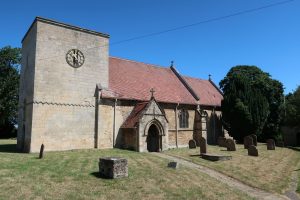
The parish of Hotham is situated in what was once the wapentake of Harthill (Hunsley Beacon division), part of the historical East Riding of Yorkshire (see maps in Introduction). It includes the locality of Hotham Carrs.
Before the Conquest the parish of “Hotun” was a hotchpotch of holdings in the hands of the Anglo-Saxon lords Morcar, Thorkil, Basing and Orm. By 1086 William I and the bishop of Durham were the tenants in chief of the larger holdings and Count Robert of Mortain and Robert Malet the tenants in chief of the smaller ones. The bishop’s tenants were the Fitzwilliam family of Grimthorpe and the count’s tenants the Fossards followed by the Mauleys. The family that took the name Hotham became subtenants of the latter two families, but over the ensuing centuries the ownership of the many other holdings in the parish becomes too complicated to be set out here. Suffice it to say that it involved the king, the Knights Templar and many noble families – Babthorpe, de Brus, Clitherow, Fairfax, Fauconberg, Neville, St. Quintin, Stuteville, Vescy – who were connected to a greater or lesser extent with one or more of the families that took the name Pickering.

A manor house was mentioned in c1530 and shown on maps of the village of Hotham as late as 1950; on current maps the area where it stood is designated as Manor Farm. Hotham manor house is not to be confused with Hotham Villa, Hotham House or Hotham Hall. The Burton family bought the manor of Hotham in 1719 and the manor of the neighbouring parish of North Cave in 1773. It was in North Cave that they built their residence and gave it the confusing name of Hotham Hall.
The church is dedicated to Saint Oswald and dates back to Norman times, as illustrated by the Norman tower with its belt of zigzag work. It was restored in 1789, the nave was extended eastwards beyond its Norman arch in the early 1800s and the chancel and the nave underwent extensive restoration work in 1905. An unusual feature is the gallery with its own fireplace overlooking the nave. The stained glass windows show versions of the arms of the Burtons family and those of their successors, the Clitherows, who used the gallery as their private place of worship.
 right: fireplace in gallery, 2022 |  |  |  left: gallery and Norman arch, 2022 |
Matthew Pickering, the first known member of the Pickerings of Misson, came from a branch of the Pickerings settled in Nottinghamshire. This Matthew’s great great grandson, also a Matthew, was the servant of the Reverend James Stillingfleet, and as such followed his master when he moved to Yorkshire. The Stillingfleets’ ancient roots were in the the East Riding, and the reverend took up the rectorship of Hotham church in 1771. Matthew married a local woman and their son, another Matthew, and his wife were already established members of the community when, at the age of over 50, they decided to follow their daughters and sons-in-law to Ontario, Canada in 1831.
Sources:
https://www.genuki.org.uk/big/eng/YKS/ERY/Hotham
https://intel-hub.eastriding.gov.uk/parish-profile/#/view-report/bd6a0cb7f85a46998f874a42bfd0dc8e/PP075
https://en.wikipedia.org/wiki/Hotham,_East_Riding_of_Yorkshire
https://opendomesday.org/place/SE8934/hotham
Victoria History of the County of York: East Riding, vol. 4, pp. 116-118
History and Topography of Yorkshire, vol. 2, York, Ainsty, East Riding, pp. 543-4: https://books.google.fr/books?redir_esc=y&id=unEKAQAAMAAJ
A New and Complete History of the County of York, vol. 3, p. 356: https://books.google.fr/books?redir_esc=y&id=sIcOAAAAQAAJ
A History of South Cave and of other Parishes in the East Riding of the County of York: https://web.archive.org/web/20091003154011/http://members.pcug.org.au/~bthompso/southcave/openff.pdf
Hotham Hall: https://www.yorkshiregardenstrust.org.uk/index.php/research/sites/hotham-hall
Church of Saint Oswald: https://historicengland.org.uk/listing/the-list/list-entry/1083305?section=official-list-entry
